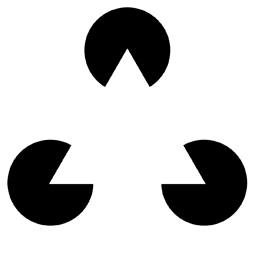


 |
||
 |
||
|
Do you see a triangle in this picture? The brain tries to make sense of the picture and assumes that it is a three-dimensional image of a white triangle on top of three circles. This assumption leads the brain to perceive lines that do not exist but which complete the sides of the triangle. The color of the triangle also appears to be brighter than the area surrounding it, and that's an illusion as well. This is known as the Kanizsa Triangle, named for the Italian psychologist who first described it, Gaetano Kanizsa. Even when we know there's no triangle here, we still see one, as well as the imaginary lines that distinguish it from the background. Recent research has shown that brain cells whose job it is to identify lines are also activated by imaginary lines. However, there is a scientific debate about the explanation. Does it mean that even at low levels of processing the brain "completes" information? Or is the top- down effect at work in the parts of the brain responsible for identifying shapes and seeing three dimensions? The fact that the white triangle appears to be lighter than its background can be explained with the help of another familiar "relative lightness" illusion. We see the three angles of the "triangle" against a dark background (circles), which is why they appear to be lighter in shade. We complete this (incorrect) information in each of these areas of the "triangle." Links: Related exhibit:
|
||

 The Imaginary Triangle
The Imaginary Triangle